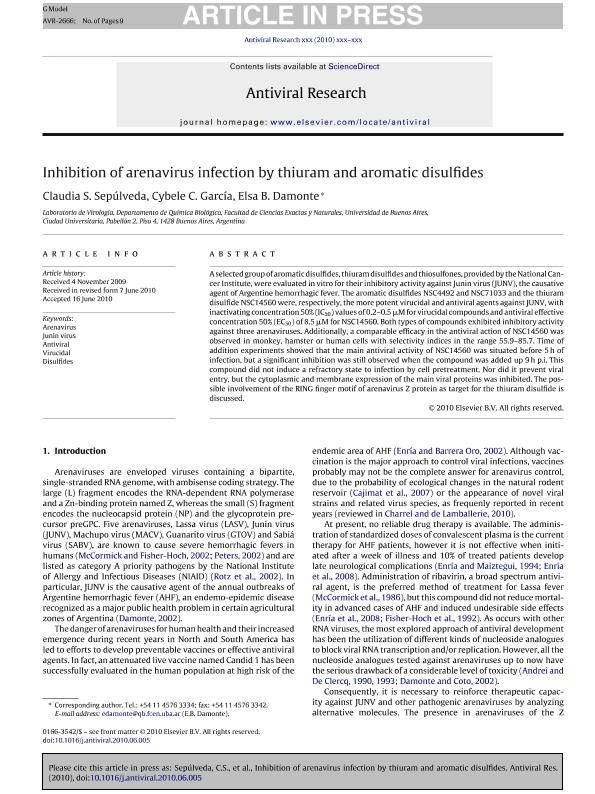Mostrar el registro sencillo del ítem
dc.contributor.author
Sepúlveda, Claudia Soledad

dc.contributor.author
García, Cybele C.
dc.contributor.author
Damonte, Elsa Beatriz

dc.date.available
2020-09-03T20:43:24Z
dc.date.issued
2010-09
dc.identifier.citation
Sepúlveda, Claudia Soledad; García, Cybele C.; Damonte, Elsa Beatriz; Inhibition of arenavirus infection by thiuram and aromatic disulfides; Elsevier Science; Antiviral Research; 87; 3; 9-2010; 329-337
dc.identifier.issn
0166-3542
dc.identifier.uri
http://hdl.handle.net/11336/113189
dc.description.abstract
A selected group of aromatic disulfides, thiuram disulfides and thiosulfones, provided by the National Cancer Institute, were evaluated in vitro for their inhibitory activity against Junin virus (JUNV), the causative agent of Argentine hemorrhagic fever. The aromatic disulfides NSC4492 and NSC71033 and the thiuram disulfide NSC14560 were, respectively, the more potent virucidal and antiviral agents against JUNV, with inactivating concentration 50% (IC50) values of 0.2-0.5μM for virucidal compounds and antiviral effective concentration 50% (EC50) of 8.5μM for NSC14560. Both types of compounds exhibited inhibitory activity against three arenaviruses. Additionally, a comparable efficacy in the antiviral action of NSC14560 was observed in monkey, hamster or human cells with selectivity indices in the range 55.9-85.7. Time of addition experiments showed that the main antiviral activity of NSC14560 was situated before 5h of infection, but a significant inhibition was still observed when the compound was added up 9h p.i. This compound did not induce a refractory state to infection by cell pretreatment. Nor did it prevent viral entry, but the cytoplasmic and membrane expression of the main viral proteins was inhibited. The possible involvement of the RING finger motif of arenavirus Z protein as target for the thiuram disulfide is discussed.
dc.format
application/pdf
dc.language.iso
eng
dc.publisher
Elsevier Science

dc.rights
info:eu-repo/semantics/openAccess
dc.rights.uri
https://creativecommons.org/licenses/by-nc-sa/2.5/ar/
dc.subject
ANTIVIRAL
dc.subject
ARENAVIRUS
dc.subject
DISULFIDES
dc.subject
JUNIN VIRUS
dc.subject
VIRUCIDAL
dc.subject.classification
Virología

dc.subject.classification
Ciencias Biológicas

dc.subject.classification
CIENCIAS NATURALES Y EXACTAS

dc.title
Inhibition of arenavirus infection by thiuram and aromatic disulfides
dc.type
info:eu-repo/semantics/article
dc.type
info:ar-repo/semantics/artículo
dc.type
info:eu-repo/semantics/publishedVersion
dc.date.updated
2020-09-03T16:53:22Z
dc.journal.volume
87
dc.journal.number
3
dc.journal.pagination
329-337
dc.journal.pais
Países Bajos

dc.journal.ciudad
Amsterdam
dc.description.fil
Fil: Sepúlveda, Claudia Soledad. Universidad de Buenos Aires. Facultad de Ciencias Exactas y Naturales. Departamento de Química Biológica. Laboratorio de Virología; Argentina. Consejo Nacional de Investigaciones Científicas y Técnicas. Oficina de Coordinación Administrativa Houssay; Argentina
dc.description.fil
Fil: García, Cybele C.. Universidad de Buenos Aires. Facultad de Ciencias Exactas y Naturales. Departamento de Química Biológica. Laboratorio de Virología; Argentina
dc.description.fil
Fil: Damonte, Elsa Beatriz. Consejo Nacional de Investigaciones Científicas y Técnicas. Oficina de Coordinación Administrativa Houssay; Argentina. Universidad de Buenos Aires. Facultad de Ciencias Exactas y Naturales. Departamento de Química Biológica. Laboratorio de Virología; Argentina
dc.journal.title
Antiviral Research

dc.relation.alternativeid
info:eu-repo/semantics/altIdentifier/url/https://www.sciencedirect.com/science/article/abs/pii/S0166354210006388
dc.relation.alternativeid
info:eu-repo/semantics/altIdentifier/doi/https://doi.org/10.1016/j.antiviral.2010.06.005
Archivos asociados
